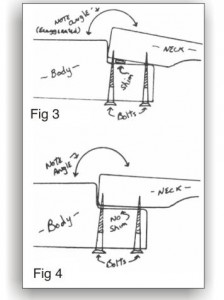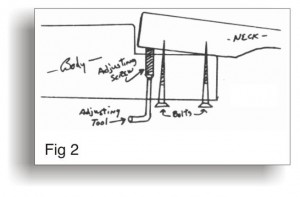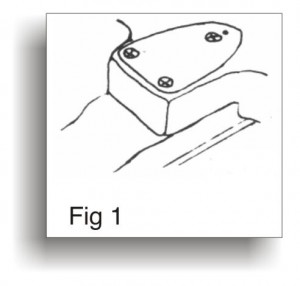FUNCTION OF THE NECK SET: To align the neck properly with the body.
INDICATION OF PROBLEMS WITH THE NECK SET: Proper action can not be obtained.
WHAT TO LOOK FOR: If you have properly straightened the neck and you have lowered your bridge and/or saddles as low as possible, and you find that the action is still too high… then the neck set is too low.
Or (less common) if the bridge is as high as it will go and your strings still buzz/hit the frets… then the set of the neck is too high. These adjustments are related to the way the neck fits the body, called the NECK SET.
If you have an instrument that has a glued in neck (often called a SET NECK) then you will need to have a professional repairperson look at this problem. But if your instrument has a bolt on neck, FOUND ON MANY ELECTRICS BUT FEW ACOUSTICS (See Fig. #1), where bolts hold the neck to the body, you should be able to reset this type of neck yourself.
ADJUSTMENTS: Again, we must work from a common point or reference, which is the instrument with all the strings on and tuned to standard pitch. With this done, look at how high the strings are off the fret board (or how close, if too close). Now loosen all the strings (you shouldn’t have to take them off) and take the large screws out of the back. This loosens the neck from the body of the instrument. Very carefully, remove the neck from the body. When you do this, watch for “shims” that might already be in place. A shim is a small piece of material, which could be plastic, wood or cardboard, usually about the thickness of a matchbook cover. Matter of fact, matchbooks make good shims. By placing a shim under the end of the neck (See Fig. #3) you will change the angle at which the neck sits in relation to the body.

By removing a shim you will cause a change in the opposite direction (See Fig. #4) If the strings were too high, add shims. (If there are already shims in the neck joint, you must add to them.)
If the strings were too low, we will want to take away some shims (if any). If the strings are too low and there are no shims to take away and your bridge is as high as it will go, then this is a job for professional repairperson.
After you have made the adjustment, re-bolt the neck to the instrument, put the strings back, tune to pitch, then look at the results. If you feel more adjustment is required (more or less shims), repeat the above steps until you are happy with the results. This often takes several tries, I know it’s a hassle, but be patient!!
Some bolt on necks have adjustors built-in. These are usually some type of small recessed allen screw which take the place of the shim and are accessed through the plate on the back of the guitar. (See Fig. #2) Here you don’t have to remove the neck, just loosen the bolts slightly, make the adjustment to the recessed screw and re-tighten the bolts. Re-tune to pitch, check action and re-do until you are happy with the results.
Here you don’t have to remove the neck, just loosen the bolts slightly, make the adjustment to the recessed screw and re-tighten the bolts. Re-tune to pitch, check action and re-do until you are happy with the results.
CAUTION: If you do this yourself, one of the first things you will realize is that it doesn’t take much thickness in the shim to affect the neck set. Often, it just takes the thickness of one or two pieces of masking tape to put the neck where it needs to be. This can be frustrating, you may want to consider having your local repairperson do this for you.

